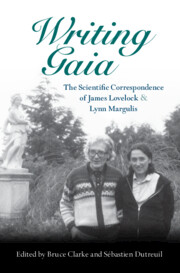Book contents
- Writing Gaia: The Scientific Correspondence of James Lovelock and Lynn Margulis
- Reviews
- Writing Gaia: The Scientific Correspondence of James Lovelock and Lynn Margulis
- Copyright page
- Epigraph
- Table of Contents
- Figures
- Contributors
- Foreword by James Lovelock
- Preface
- Acknowledgements
- Introduction
- Part I 1970–1972
- Part II 1973–1979
- Part III 1980–1991
- 1980
- 1981
- 1982
- 1983
- 1984
- 1985
- 1986
- 1987
- 1988
- 1989
- 1990
- 1991
- Part IV 1992–2007
- Part V Commentaries on Lovelock and Margulis
- Glossary of Names
- Glossary of Terms
- Bibliography
- Index
1986
from Part III - 1980–1991
Published online by Cambridge University Press: 28 July 2022
- Writing Gaia: The Scientific Correspondence of James Lovelock and Lynn Margulis
- Reviews
- Writing Gaia: The Scientific Correspondence of James Lovelock and Lynn Margulis
- Copyright page
- Epigraph
- Table of Contents
- Figures
- Contributors
- Foreword by James Lovelock
- Preface
- Acknowledgements
- Introduction
- Part I 1970–1972
- Part II 1973–1979
- Part III 1980–1991
- 1980
- 1981
- 1982
- 1983
- 1984
- 1985
- 1986
- 1987
- 1988
- 1989
- 1990
- 1991
- Part IV 1992–2007
- Part V Commentaries on Lovelock and Margulis
- Glossary of Names
- Glossary of Terms
- Bibliography
- Index
Summary
The 1980s witnessed a significant renewal of interest in Vladimir Vernadsky’s concept of the biosphere (Polunin and Grinevald 1988). Save within the ecosystem ecology transmitted through G. Evelyn Hutchinson (Grinevald 1998), Vernadsky had been largely forgotten. Likely due to her original work recovering the Russian thinker’s standing behind her theory of symbiogenesis, Margulis herself was happy to see Vernadsky take a bow as a valuable precursor of the Gaia concept.371 However, on more than one occasion in the correspondence, Lovelock informed Margulis that upon consideration, he found Vernadsky’s importance in this regard to be minor at best. We think that an important component of the general revival of interest in Vernadsky at that moment is that the wider calls in the Earth sciences for a grand new research program also required a “great” precursor on which to stand. And after Lovelock’s numerous controversial positions on CFCs, ozone, and other environmental issues, it was not possible for a program tackling global change to acknowledge a direct line of inheritance from Gaia.372
- Type
- Chapter
- Information
- Publisher: Cambridge University PressPrint publication year: 2022



